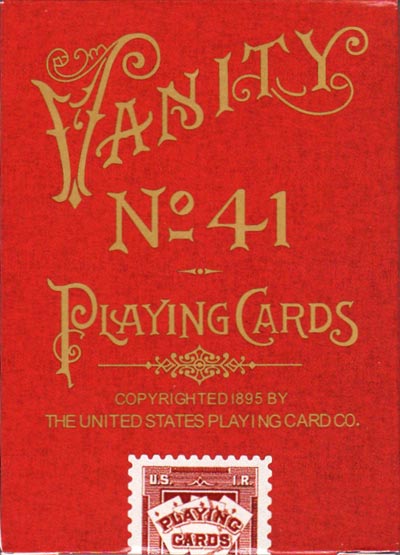Vanity Fair
Vanity Fair No.41 Playing Cards by the United States Playing Card Co, 1895. All the number cards have been imaginatively transformed.
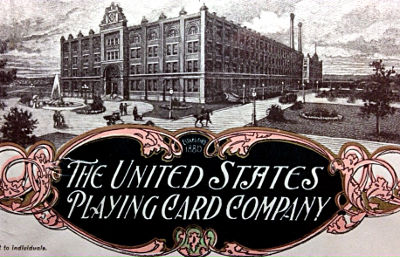
“Vanity Fair” Transformation Playing Cards published by the United States Playing Card Company, 1895, 53 cards in box. All the number cards have been imaginatively transformed and the double-ended court cards have been modified into comical images. The king of spades smokes a pipe, the queen holds a spoon, and the jack holds a shovel. The ace of spades depicts Uncle Sam and Miss Liberty in full colour and reads "Vanity Fair No. 41, copyrighted 1895 by The United States Playing Card Company, Cincinnati, U.S.A." The Joker is a winged devil with a pitchfork. The back design is a centre medallion with four Asian faces wearing caps, all within a snowflake pattern, and comical faces appear in the four corners, printed in green.
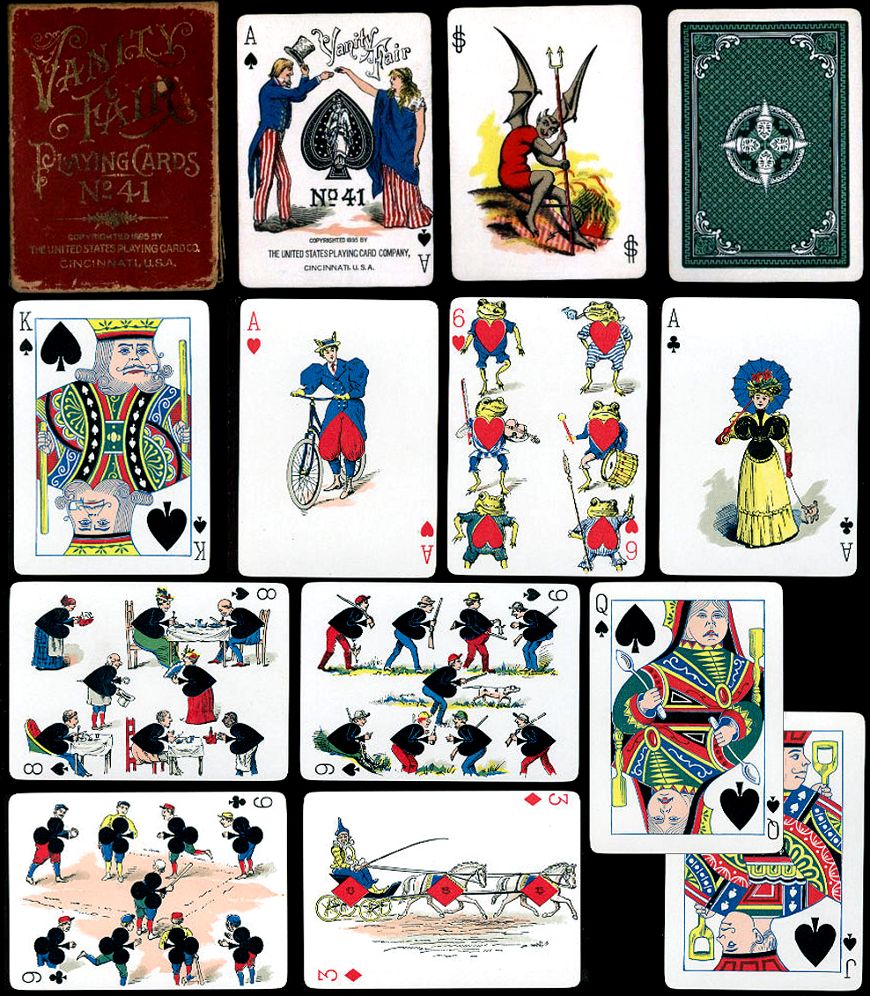
Above: “Vanity Fair” Transformation Playing Cards published by the United States Playing Card Company, 1895. Several different backs and box designs are known - click image to see more.
Reproduction by Fournier in 1998
The Vanity Fair deck was reproduced by Fournier in 1998. It is exactly the same as the original except that it is bridge size. The original deck is poker size. At the time, USPC owned a controlling interest in Fournier.
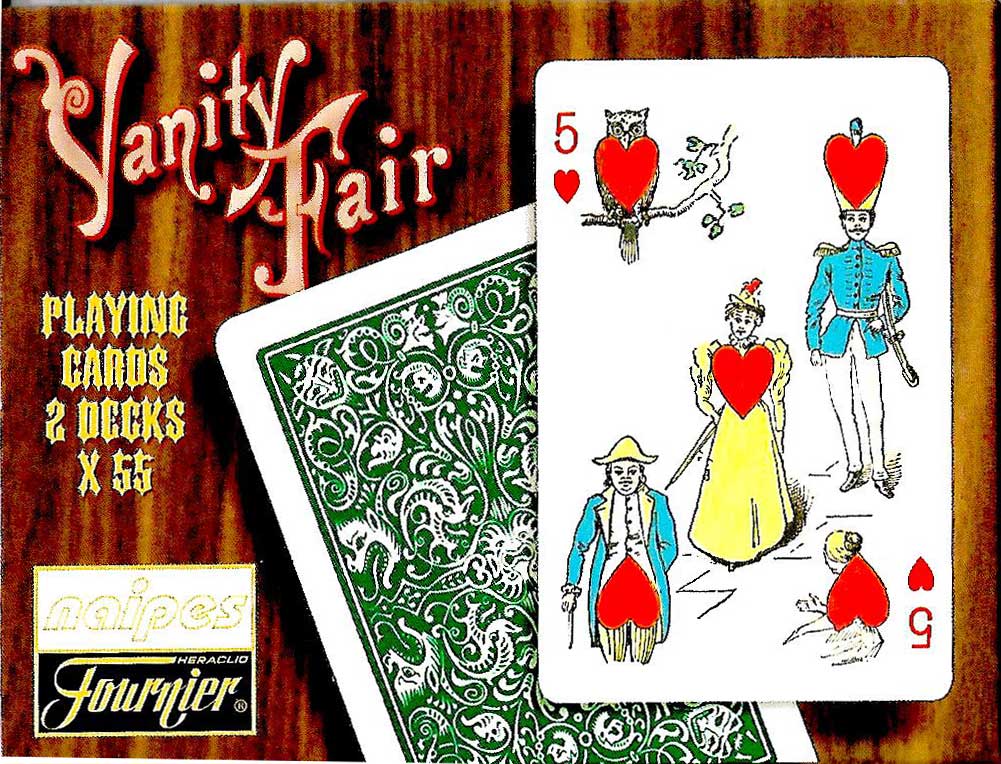
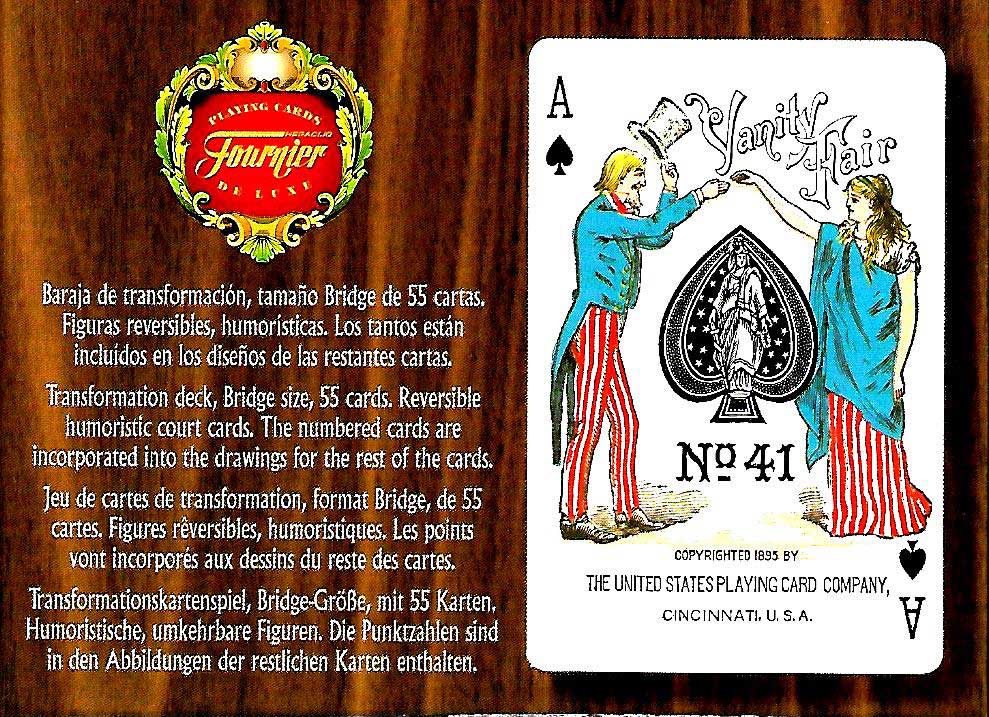
Above: front and back of double boxed set of reproduction Vanity Fair Transformation cards published by Naipes Fourner, 1998. Even though the cards are bridge size, the pictures are still the same size as the originals. I would think that the original plates were used to produce this repro. Image courtesy Rod Starling.
Reproduction by Playingcarddecks.com, 2019
Reviewed by Matt Probert.
Vanity No 41 Playing Cards (reproduction based on the "Vanity Fair No 41" transformation deck by US Playing Card Co., 1895), produced by Will Roya, illustrated by Azured Ox, printed by USPCC in two colours: red and green, limited edition of 2000 packs each colour.
Like the 19th century originals, the reproduction pack is cut to poker width. In addition, the reproduction packs includes an additional joker where the devil is wearing green, but otherwise identical to the other joker; a double-back card and an alternative nine-of-diamonds to further expand the scope for use by card magicians.
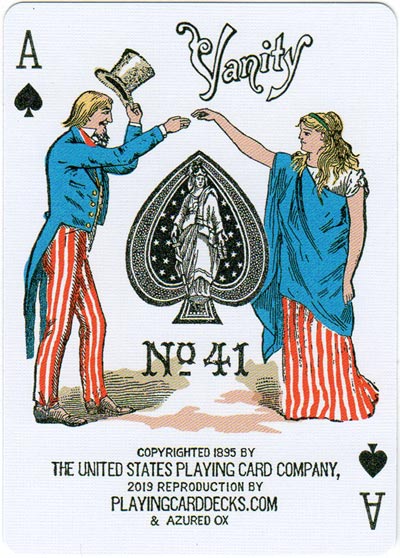
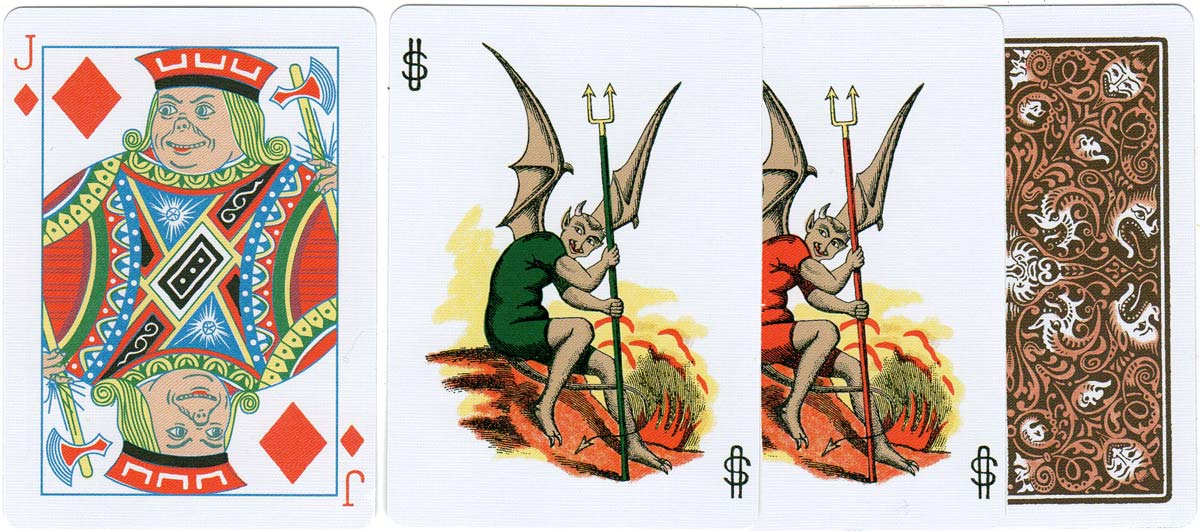
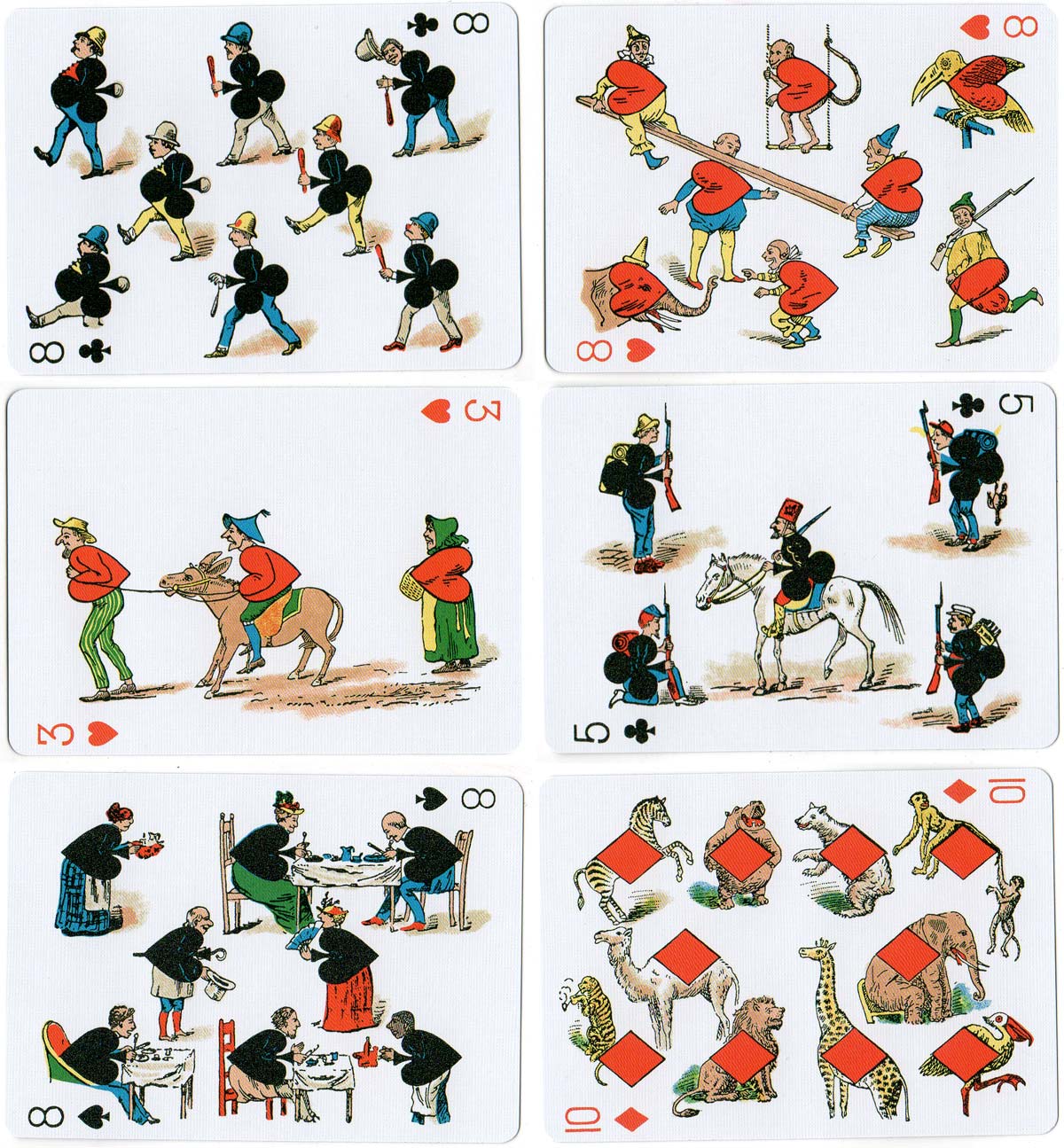
Above: Vanity No 41 Transformation Playing Cards produced by card magician Will Roya, illustrated by Azured Ox, manufactured by USPCC, 2019 in two colours: red and green (each with a different back design copied from originals) in a limited edition of 2000 packs of each colour. The red pack has the hobgoblin design as used in the 1998 reproduction pack published by Fournier, only printed in brown; while the green pack is printed with the "clown" back.
The designs themselves have been reproduced from originals, though some minor differences occur. Most obviously in the nine-of-clubs where the original card design has the legs trimmed off the boy in the top left corner of the card, the reproduction pack depicts the whole boy. To my mind a better image than the original pack. Less obviously, the spacing in the top left corner of the six-of-hearts between the index and the toad is clearer in the reproduction pack. The original is rather cramped, with the heart suit indicator almost touching the toad’s arm. The reproduction pack has the main image better located within a more centralised position. Other cards show slight variations to the original images, but in no way detract from the comic nature or general essence of the originals.
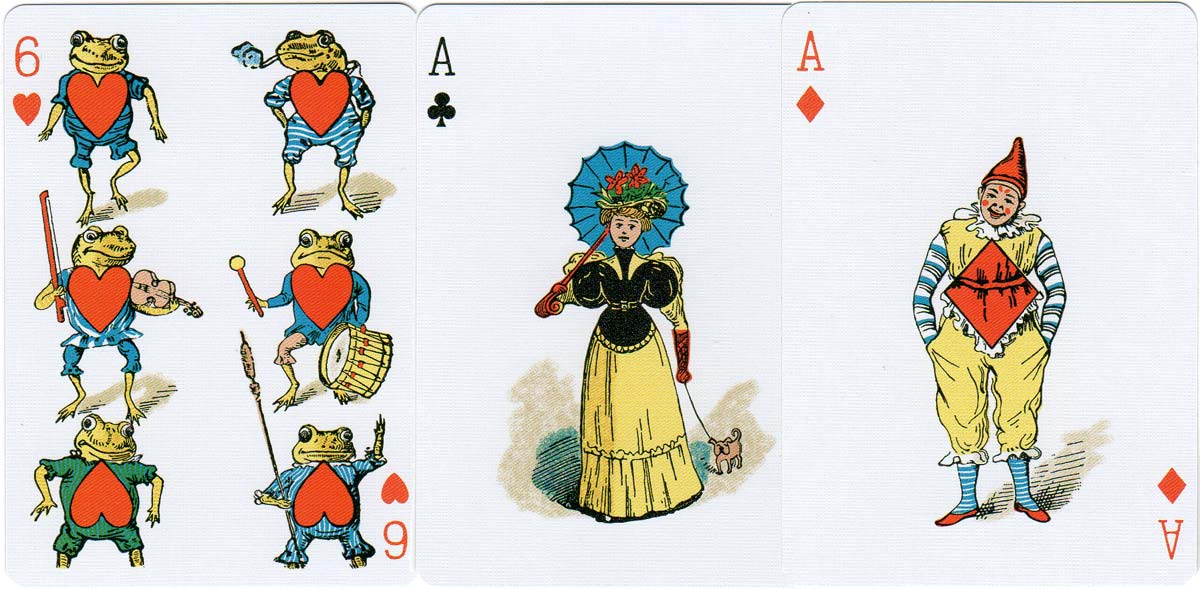
Each pack is supplied in a colour coordinated box - either red or green, corresponding to the colour of the backs of the cards inside, and printed with gold ink and sealed with an imitation tax stamp (of a design used between 1894 and 1896) and wrapped in cellophane.
The cards are produced on Bicycle playing card board, in poker width, with the same embossing and finish to provide the finish that is preferred by card magicians, one of the key target audiences for this pack. As a magic theatre prop these cards excel. For collectors the pack offers an opportunity to own the art work of the popular USPCC Vanity Fair pack without having to pay the earth trying to source a rare original. Packs are sold either as a pair comprising one pack of each colour; individually or as an uncut sheet. To prevent the cards being passed off as originals the ace of spades in the reproduction pack has different wording to the original. The title has been reduced to “Vanity”, the word “Fair” having been dropped, and the copyright information at the base of the card has replaced “Cincinnati, USA” with a reproduction notice thus: “2019 REPRODUCTION BY PLAYINGCARDDECKS.COM & AZURED OX”.


By Simon Wintle
Member since February 01, 1996
I am the founder of The World of Playing Cards (est. 1996), a website dedicated to the history, artistry and cultural significance of playing cards and tarot. Over the years I have researched various areas of the subject, acquired and traded collections and contributed as a committee member of the IPCS and graphics editor of The Playing-Card journal. Having lived in Chile, England, Wales, and now Spain, these experiences have shaped my work and passion for playing cards. Amongst my achievements is producing a limited-edition replica of a 17th-century English pack using woodblocks and stencils—a labour of love. Today, the World of Playing Cards is a global collaborative project, with my son Adam serving as the technical driving force behind its development. His innovative efforts have helped shape the site into the thriving hub it is today. You are warmly invited to become a contributor and share your enthusiasm.
Related Articles

Rap Rummy
Rap Rummy made by Parker Brothers in 1926, only 4 years after the discovery of King Tutankhamen’s to...

German Travel Cards
A travel-themed educational deck helping American tourists visiting Germany.

Can You Believe Your Eyes?
“Can You Believe Your Eyes?” playing cards featuring visual illusions & other oddities.

An Anonymous Belgian Transformation Pack
Anonymous Belgian transformation pack borrowing many images from earlier designs by Braun & Schneide...

Get Decked
Black and white cartoons devised by Sam Wagner with help from artist Lindsay Bevington.

Beowulf
Jackson Robinson's Beowulf playing card deck inspired by the Old English pagan poem.

Keith Haring playing cards
Energetic graffiti images by the American artist Keith Haring.

The Tarot of Meditation – Yeager Tarot
Marty Yeager’s original Tarot of Meditation from 1975, republished later by U.S. Games Systems, Inc....

Adobe Deck
The first digitally-produced deck of cards.

Seminole Wars deck
Seminole Wars deck by J. Y. Humphreys, Philadelphia, c.1819.

The UCR Deck
Giant-size cards designed by Thomas Sanders to advertise courses and facilities at UCR.

Fredericks & Mae playing cards
A rainbow pack from the design team of Fredericks & Mae and Benjamin English.

Baraja Turística del País Vasco
Basque poker deck of 55 cards published by Fournier with scenic views of the Basque Country.

Baraja Vasca
Spanish Basque Country deck with original drawings by María Isabel Ibañez de Sendadiano.

Red Hat Society playing cards
Society that encourages women in their quest to get the most out of life.

Mountain Dream Tarot
Groundbreaking Tarot created by Bea Nettles, using photographs and photo montage.
Most Popular
Our top articles from the past 28 days


